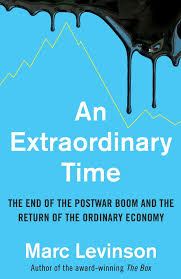When Were The Good Old Days?
Above and beyond explaining the past, history can give us perspective and helpful doses of humility. Are our experiences or abilities all that different from those in the past? It is comforting to believe that we have made great gains. Confidence in our collective abilities aside, questions remain about causality and broad trends. For example, what should we define as “normal” in terms of the macro-economy? It is critical question, particularly when voters go to the polls. Managing public expectations is at the very center of our democratic institutions.
Many Americans believe that strong economic growth and rising standards of living is how life was and should always be. Economic historian and journalist Marc Levinson explains otherwise in his well-argued book, An Extraordinary Time: The End of the Postwar Boom and the Return of the Ordinary Economy. Levinson focuses on 1973 as a pivot point in economic and political history. It marked the end of an extraordinary post-World War II boom, a period of steadily rising wages, multiple employment opportunities (regardless of income), and great expansion. The decades since, which have witnessed slower growth, balloons and busts, greater economic instability, are a return to “traditional” American economic history.
Levinson weaves together broad macroeconomic trends and global politics in the 1970s, making sure that we appreciate the complexities of the OPEC oil embargo, the abandonment of the gold standard, increased global trade, and currency speculation. There are always disruptions and shocks to economic systems. What Levinson underscores is that political leaders had assumed that they could control and manage these forces. After all, they had successfully done so since the late 1940s – the “extraordinary times” of his title. But by the Nixon and Ford administrations, there were no magic bullets. A range of policies were tried without success. Growth slowed, times got harder, and they have mostly remained so since.
Forgotten leaders, questionable theories, and difficult decisions dot An Extraordinary Time. Levinson takes a hard look at Arthur Burns, an economist who was named chairman of the Federal Reserve in 1969. Under Burns’ leadership, the Fed waged a losing battle to inflation. Broad faith in the Phillips Curve, which was supposed to explain the relationship between inflation and employment, muddied policy decisions. Gordon Richardson, head of the Bank of England, tried with limited success to bring greater stability to international banking. The most important underlying fact, Levinson argues, is the slowdown in productivity spelled the end of a post-war extraordinary time. Inequality increased and that trend that has accelerated since 1973. Social unrest followed, leading to the broad turn to the right by the late 1970s. Levinson locates the elections of Thatcher and Reagan within these broad currents of economic unrest.
An Extraordinary Time is closely researched, accessible, and a vitally important corrective to assumptions that there should always be tremendous economic growth. It makes clear that interventions in global market forces may or may not result in planned consequences. Levinson gives us a clear-eyed perspective on our recent history and the currents of forces that brought us here. It would be comforting to think that we are smarter today, but . . . .
David Potash